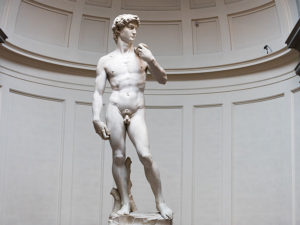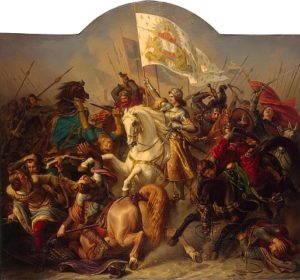A few years ago I commented on a book by philosopher Edward Feser titled The Last Superstition. Feser laid out the reasoning of ancient philosophers, emphasizing Aristotle, showing how the existence of physical things pointed unmistakeably to a non-physical reality behind it. Feser’s book ended with a saying attributed to Confuscious: when the finger points to the moon, the fool looks at the finger. Material reality is the finger, but it is pointing to spiritual reality. So, as Feser wrote to the latest crop of atheists: “It’s the moon, stupid.” That was the title of my blog.
 I have a similar thought about Michaelangelo’s statue of David. It points us to something else, but what? If we are given a likeness of David in order to evoke our understanding of God working through him, then the statue points to God. But is that what this statue does?
I have a similar thought about Michaelangelo’s statue of David. It points us to something else, but what? If we are given a likeness of David in order to evoke our understanding of God working through him, then the statue points to God. But is that what this statue does?
In his video series on worldview, Francis Shaeffer pointed to the Renaissance period (when this statute was sculpted, c. 1504) as being an important point of departure, historically, from a more God-centered way of thinking than obtained previously. Schaeffer’s point was that this statue, at 17.5 feet tall, glorifies David-the-man rather than the motivations that made David a hero of faith and a type of the coming Christ. This art, Schaeffer might have said, points to the summit of human virtue and beauty, not the Author of that virtue and beauty. Schaeffer generalized his observations about this statue to Renaissance art more generally. He said that period was the beginning of a shift to humanism, rather than remaining more centered on God, as with the art at the Cloisters in New York, that Sarah and I saw a few years ago. After the Renaissance, art more typically celebrated man, than God.
 I would say the purpose of art has continued to evolve significantly since the Renaissance. Much art was devoted to human historical events. Often events with religious themes, but the religious themes were secondary to the human striving. In the centuries after Joan of Arc, for example, there was much art depicting human liberation from oppression, more than the beatific vision of the liberator. (Photo: Hermann Stilke, Joan of Arc in Battle). Art sometimes explicitly points to other ideals, but not necessarily religious ones. Think of the statue of liberty. In the romantic age of art, flowering with expressionism, the art points to human sensitivity and emotion, celebrating a Rousseauian vision of our subjectivity in relation to nature, and then nature itself, as though it were self-numinous.
I would say the purpose of art has continued to evolve significantly since the Renaissance. Much art was devoted to human historical events. Often events with religious themes, but the religious themes were secondary to the human striving. In the centuries after Joan of Arc, for example, there was much art depicting human liberation from oppression, more than the beatific vision of the liberator. (Photo: Hermann Stilke, Joan of Arc in Battle). Art sometimes explicitly points to other ideals, but not necessarily religious ones. Think of the statue of liberty. In the romantic age of art, flowering with expressionism, the art points to human sensitivity and emotion, celebrating a Rousseauian vision of our subjectivity in relation to nature, and then nature itself, as though it were self-numinous.
(photo: JWW Turner, The Decline of the Carthaginian Empire)

Art splintered, I would say, after that. Sometimes to say there is no meaning, or perhaps only meaning in the real and specific, devoid of extra-material content. You might say the art pointed to an absence of meaning. In the last hundred-plus years some art says explicitly and didactically that there is no meaning, rather than merely pointing us in the direction of meaninglessness and thus to materialism. I think the reason is that art can be a signal for transcendent truth, but if there is no transcendent truth; if everything just is and has no meaning, then the purpose for art is undermined. It, too, is a thing-unto-itself, and cannot point to anything else, not even other material things.
At some point the art most celebrated by its cultural curators (that is, those who shape art markets and thus shape culture) turned a corner, so that what it pointed to was not even beauty, much less an idea to which beauty itself might point. It negated beauty and idealism. Not all art, thank goodness, but most political art is this way. It’s telling us there are no ideals other than political reaction, and so its existence is inferior to the ideal depicted, such as it is. In the same way, much art is intentionally ugly because it points away from beauty, purposely repudiating beauty as transcendently significant unto itself.
Back to David, and the statue of David. The sculpture is undeniably beautiful. Michaelangelo may have been shifting our attention from God to man, but he did not shift our attention from beauty in the abstract. Beauty itself is profound evidence of the truth of God and His realm, and so art that does not repudiate beauty at least points indirectly to God.
 Postmodern “art” is art only if we define art as visual symbolism of the spirit of the age. If you want to say life is meaningless and absurd, then you make art that tells us this. But I have to think we’re getting away from what art is, at that point. Better to just say life is meaningless and absurd because there is no reality beyond the movement of material in little dust-storms of processes, some of which are human beings. Making trash-can “art” is unnecessary to that proposition. In fact, it unwittingly pays homage to the notion that art is about beauty and transcendence, by using its forms and raising it up as a cultural totem. A bit like saying there is no God, when you really only mean the God who is, is bad. The message of modern art is that art is dead, just like Nietzche said God was. But if art is dead, why make trash-can visuals and call it art? If there is no God, why attempt puny human wars against Him with words as weapons?
Postmodern “art” is art only if we define art as visual symbolism of the spirit of the age. If you want to say life is meaningless and absurd, then you make art that tells us this. But I have to think we’re getting away from what art is, at that point. Better to just say life is meaningless and absurd because there is no reality beyond the movement of material in little dust-storms of processes, some of which are human beings. Making trash-can “art” is unnecessary to that proposition. In fact, it unwittingly pays homage to the notion that art is about beauty and transcendence, by using its forms and raising it up as a cultural totem. A bit like saying there is no God, when you really only mean the God who is, is bad. The message of modern art is that art is dead, just like Nietzche said God was. But if art is dead, why make trash-can visuals and call it art? If there is no God, why attempt puny human wars against Him with words as weapons?

1 thought on “Beauty and Art”